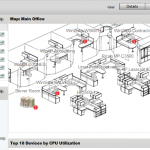This is a layer 3 switch overview; Layer 3 switches are used to route traffic between hosts at wire speed. Normal (affordable) routers are not capable of routing large amounts of data. When you enter the Layer 3 switching market, you will find a lot of products that make you dizzy. In my little search these are the vendors of layer 3 and layer 2+ switches:
- Cisco
- HP
- Huawei
- Juniper
- Brocade
- Extreme networks
- Dell
- Alcatel
- NetGear
- D-link
Types of layer 3 switches
Layer 3 switches are available as a modular chassis, standalone (fixed port) unit or as a stack device. For smaller organizations there are layer 3 switches that can be stacked. Normally this scales to approximately 400 users.
Layer 2+ (Light Layer 3 or LL3) is seen by some HP switches. This is used for inter VLAN routing (if you enable routing, it routes everything between the VLAN’s and you can make some static routes, it is not dynamic routing). Full layer 3 is dynamic routing based on metrics like cost, load and access control.
What is the difference between layer 3 switch and a router (besides speed)?
Layter 3 switches don’t support Border Gateway Protocol (BGP). Internal networks use protocols like RIP and OSPF where Routers use BGP. The functional difference is found in the stability and robustness of the BGP protocol.
Looking for detailed information on vendor websites
PS: Have you ever been navigating through HP websites? My experience with this set of websites would trigger the question: If navigating these websites represents HP routing and switching, then I’m moving to another vendor. I hope is like a Chinese restaurant: Presentation s…cks, but food is perfect.
 For a good SolarWinds ipMonitor review, some history about the product helps to understand the product and its future. In 2004 ipMonitor was a spun-off from DeepMetrix as a stand alone product. In April 2007 ipMonitor was acquired by SolarWinds and ipMonitor fills in the gab for the Orion NPM platform. SolarWinds NPM didn't have WMI, services and application monitoring capabilities in the past. SolarWinds is using the knowledge from ipMonitor to build the Application and Service Monitoring module for the Orion platform. ipMonitor is sold by SolarWinds as an entry level monitoring tool.
For a good SolarWinds ipMonitor review, some history about the product helps to understand the product and its future. In 2004 ipMonitor was a spun-off from DeepMetrix as a stand alone product. In April 2007 ipMonitor was acquired by SolarWinds and ipMonitor fills in the gab for the Orion NPM platform. SolarWinds NPM didn't have WMI, services and application monitoring capabilities in the past. SolarWinds is using the knowledge from ipMonitor to build the Application and Service Monitoring module for the Orion platform. ipMonitor is sold by SolarWinds as an entry level monitoring tool.